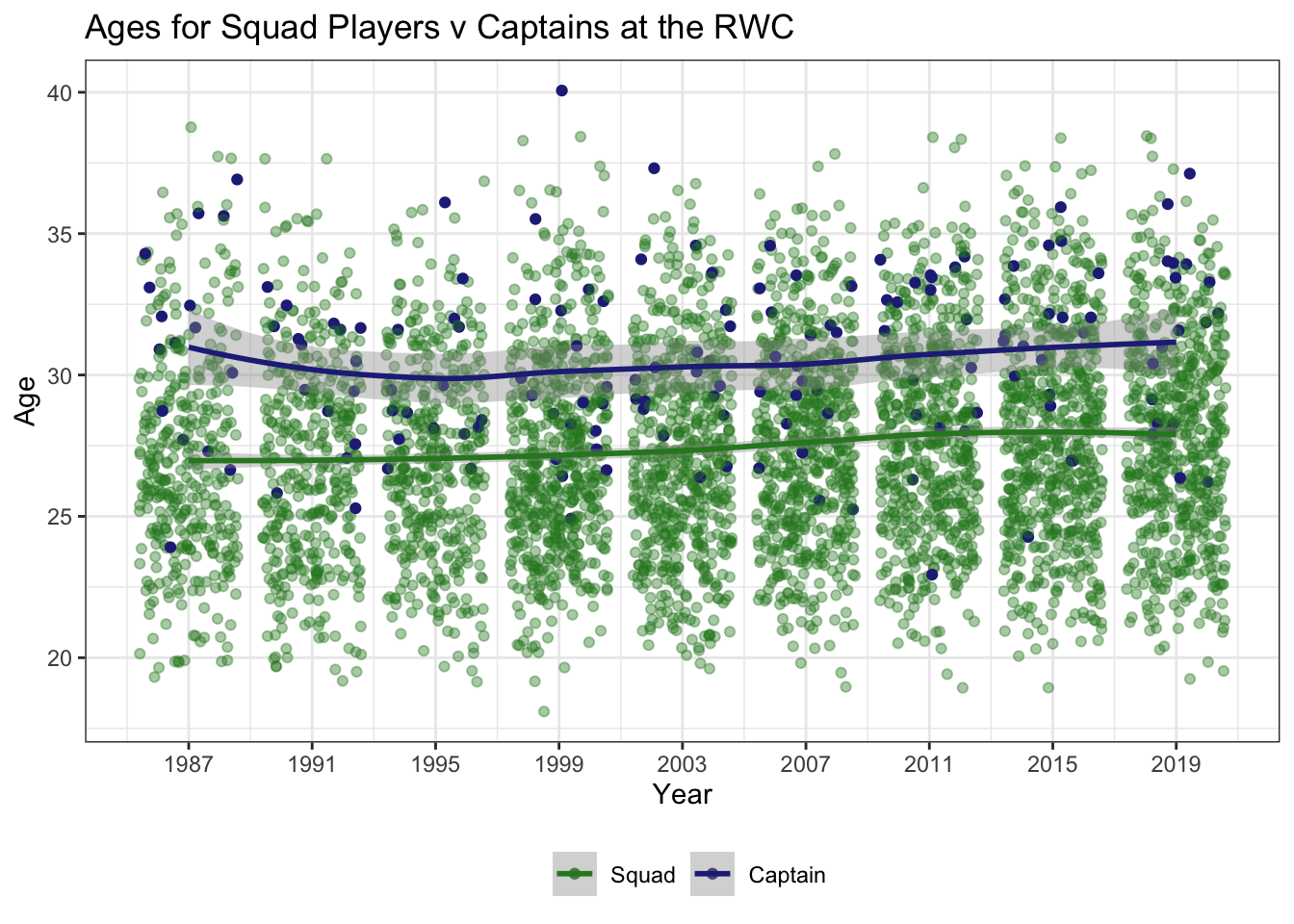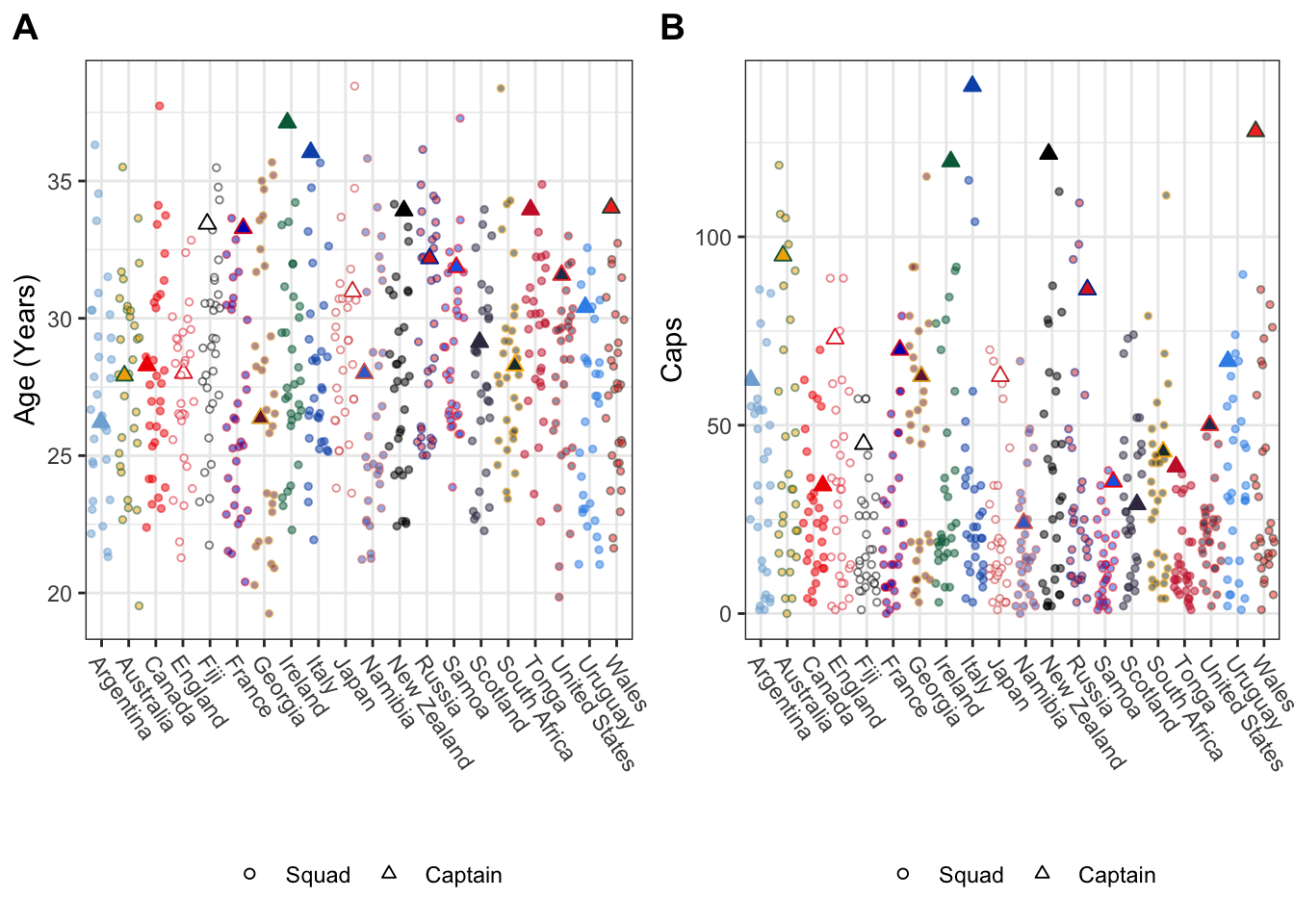What’s in a Captain?
Arthur Gymer
2019-09-24
Being the man to lead your country is an honour. Being the man who does so in a World Cup makes you a member of a very select club; one of 147 as of 2019. Using data gathered from Wikipedia, I decided to take a look at what goes into being a Rugby World Cup captain.
The Outliers
First up let’s look at the milestone men. (N.B. Cap totals do not include B&I Lions)
Father Time - oldest
| Name | RWC | Country | Caps | Age | Position |
|---|---|---|---|---|---|
| Diego Ormaechea | 1999 | Uruguay | 54 | 40y 22d | Back row |
The Stalwart - most capped
| Name | RWC | Country | Caps | Age | Position |
|---|---|---|---|---|---|
| Richie McCaw | 2015 | New Zealand | 142 | 34y 269d | Back row |
Young Gun - youngest
| Name | RWC | Country | Caps | Age | Position |
|---|---|---|---|---|---|
| Sam Warburton | 2011 | Wales | 17 | 22y 344d | Back row |
The Newbie - least capped
| Name | RWC | Country | Caps | Age | Position |
|---|---|---|---|---|---|
| Malcolm Jellicoe | 1987 | Zimbabwe | 0 | 23y 331d | Scrum-half |
| Brian Currin | 1991 | Zimbabwe | 0 | 31y 25d | Fullback |
Wait. Something seems up here. The two Zimbabwe captains really made their debuts, as captains, in Rugby World Cups? There are a couple of factors at play here:
- Zimbabwe only played their first test match in 1981/82, prior to this they competed as sides of colonial Rhodesia
- Their two appearances were in ’87 and ’91, when the game was amateur and the record keeping - particularly for smaller nations - was sparse
A little digging suggests that Jellicoe may indeed have made his debut at the 1987 event, and ESPN Scrum suggests Currin won his sole 3 caps in 1991. However, taking a closer look at the ESPN Scrum pages shows that although they record Zimbabwe as having played over 45 tests between 1981 and 1991, many of these have no team-sheet for Zimbabwe. Therefore it is likely that both players had accrued caps at the time of their captaincy, but that these are not on public record.
If we exclude the Zimbabweans then we find the next least-capped RWC captain hails from the Pacific.
| Name | RWC | Country | Caps | Age | Position |
|---|---|---|---|---|---|
| Mana Otai | 1995 | Tonga | 2 | 26y 252d | Back row |
A check of ESPN Scrum reveals that the record keeping for Tonga in the 91-95 era covered team sheets, and the cap count for Mana ’Otai appears accurate.
So Good They Named Them Twice
World Cup Captains are a select bunch but a very few players have shouldered the responsibilty on multiple occasions. Two men, Richie McCaw and Sergio Parisse, titans of the game and revered by rugby fans across the globe, have taken the armband 3 times on the biggest stage. Just 17 more have held the position twice.
| Name | Country | RWCs | Times Captain |
|---|---|---|---|
| Sergio Parisse | Italy | 2011, 2015, 2019 | 3 |
| Richie McCaw | New Zealand | 2007, 2011, 2015 | 3 |
| Michael Leitch | Japan | 2015, 2019 | 2 |
| Tyler Ardron | Canada | 2015, 2019 | 2 |
| Nili Latu | Tonga | 2007, 2015 | 2 |
| Thierry Dusautoir | France | 2011, 2015 | 2 |
| Jacques Burger | Namibia | 2011, 2015 | 2 |
| Sam Warburton | Wales | 2011, 2015 | 2 |
| John Smit | South Africa | 2007, 2011 | 2 |
| Brian O’Driscoll | Ireland | 2007, 2011 | 2 |
| Raphaël Ibañez | France | 1999, 2007 | 2 |
| Agustín Pichot | Argentina | 2003, 2007 | 2 |
| Takuro Miuchi | Japan | 2003, 2007 | 2 |
| Semo Sititi | Samoa | 2003, 2007 | 2 |
| Martin Johnson | England | 1999, 2003 | 2 |
| Greg Smith | Fiji | 1999, 2003 | 2 |
| Gareth Rees | Canada | 1995, 1999 | 2 |
| Will Carling | England | 1991, 1995 | 2 |
| Peter Fatialofa | Samoa | 1991, 1995 | 2 |
There are a couple of takeaways from this list:
- No captain from the inaugural tournament made lead a return.
- Only two players captained at non-consecutive tournaments
- Nili Latu, who led Tonga in ’07 and ’15 was not picked for 2011
- Raphaël Ibañez who took France to a final in ’99 and took charge again on home soil in ’07 was in the team in 2003 but the squad was led by Fabien Galthié
Caps
From previous analysis we know that the number of caps available has increased, and as a result the average player is more capped in 2019 than in 1987. However, does this hold true for captains?
 It appears that the rate of cap increase for captains actually exceeds that for the average squad player. However this may simply be selection bias; captains are likely to be experienced players, and it’s the experienced players that are increasing their cap count the most. There is also more variance in the captain cap counts.
It appears that the rate of cap increase for captains actually exceeds that for the average squad player. However this may simply be selection bias; captains are likely to be experienced players, and it’s the experienced players that are increasing their cap count the most. There is also more variance in the captain cap counts.
Age
Previous analysis also showed that there has been little if no change in the average player age. Again let’s look at whether this holds true for captains.

So the answer is yes. Although captains are generally older than the average squad player, the difference has held steady across the years, and captains in 2019 are no older on average than those of 1987.
Positions
We also have data on the position of each squad member, although it is not highly granular; there is no distinction between tight-head and loose-head for example.
First let’s take a look at how which positions supplied the most leaders. N.B. Captains who appeared more than once are counted here more than once.

Ok, it looks like the back row looms large when it comes to producing captains, but there are more back-row (6,7,8) on the field than any other position. Perhaps this is simply a function of that. A blunt way of controlling for this is to look at what proportion of selected players were captains at each position.
 Now we see that the back-row supremacy is not quite as pronounced as it seems, with hookers notably rising in terms of captains supplied per-player at positon.
Now we see that the back-row supremacy is not quite as pronounced as it seems, with hookers notably rising in terms of captains supplied per-player at positon.
Status Within Squad
So it seems that captains are typically more capped and older than the average squad player. However, can we dig a little deeper on this matter? It’s possible that a young or inexperienced captain is actually still one of the more senior players in the squad. To demonstrate the concept let’s look at where the 2019 captains rank within their teams in terms of age and caps.
 Looking at the caps plot (B) we can see a good example of this with Tonga and Samoa. Although their captains are relatively inexperienced compared to other nations leading men, they are the most and second-most capped players in their own squads respectively.
Looking at the caps plot (B) we can see a good example of this with Tonga and Samoa. Although their captains are relatively inexperienced compared to other nations leading men, they are the most and second-most capped players in their own squads respectively.
To try and tease out the most/least experienced captains relative to the squads they headed we can get their age and cap rankings within the team. However over the years there have been changes to squad sizes and some teams have taken more players than others, so a raw rank may not give the best picture. To control for this we normalise the rankings between 0 (least capped/youngest) and 1 (most capped/oldest). A very small amount of noise has been added to the ranks to allow overlapping points to be seen, although zooming is still required; take a close look at the points in the (1,1) position.
You can explore the data more closely, but the main takeaway is that the majority of captains are clustered in the top right-hand corner indicating they are relatively more-capped and older than their squadmates. You can see the relatively inexperienced outliers in the bottom left quadrant, with Sam Warburton in 2011 probably the biggest name. Will Carling was also younger than much of his team in 1991, although had earned more caps than most. Malcolm Jellicoe for Zimababwe in the inaugural event appears to be the most inexperienced relative to his teammates, but as discussed above the cap record-keeping for the Zimbabwean teams is somewhat suspect, and indeed all but one player in his squad are listed as having 0 caps.
Clubs
Lastly we have club data for most players. It is quite uncurated, with many clubs appearing under subtle variations of names, and some players being listed with multiple clubs. I have not cleaned this data, but within years/teams the expectation is that it is quite consistent. Therefore we can try to look at what relation a captain’s club might have on his selection. One possibility here is that a player who plays regularly with a higher proportion of the squad might be more likely to be selected as captain as he will have good relations already, whilst another is that you might select a player who is not already teammates with many others in order to prevent any sort of clique forming, or making players not associated with the captain’s club feel at odds.
It does not appear that there is any correlation between captains and how many teammate’s play their club rugby with them, however there is perhaps a slight downward trend over the years with fewer players being concentrated in 1 club; the Argentine national team being a notable exception with the Jaguares.
Conclusion
So what makes a World Cup captain? Well it seems like there is no hard and fast rule, but if you are a older and more-capped than your teammates and play in the back-row you probably help your odds. And I leave you with one final graph, that will let you explore every player to be selected for a World Cup, by nationality, year, and whether they were the man with a C by their name on the teamsheet.
Thanks for reading!